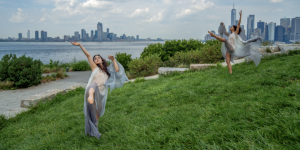IMPRESSIONS: "Lists of Promise" by Ildiko Nemeth and Lisa Giobbi with Marie Glancy O’Shea at Theater for the New City

Lists of Promise
Presented by Theater for the New City and Crystal Field in association with Bill and Maura Haney, the Long Point Fund and New Stage Theatre Company
Created by Ildiko Nemeth and Lisa Giobbi with Marie Glancy O’Shea
Directed by Ildiko Nemeth
Aerial Choreography by Lisa Giobbi
Set Design and Sculptures by Tamar Mogendorff
Lighting Design by Federico Restrepo
Costume Design by Tamar Mogendorff in collaboration with Jessica Mitrani
With Amanda Langberg Hermansen, Elena Lozonschi, Elizabeth Foster, Jacob McKee, Lainey Mackinnon, Lisa Giobbi, Rebecca Magazine, Renee Erikson, Sarah Lemp, Tatyana Kot
In the beginning, God was a woman...
This opening line from Merlin Stone’s 1976 book When God Was a Woman inspired Lists of Promise, which ran at Theater for the New City from March 13 to 30, 2025. Playwright and director Ildiko Nemeth, choreographer and aerialist Lisa Giobbi, and writer Marie Glancy O’Shea draw from Stone’s thesis: that the rise of monotheistic religions (Judaism, Christianity, and Islam) suppressed goddess-reverent cultures. These religions ushered in an era of patriarchy from which women have suffered and against which they have rebelled ever since.

Five women actors tell that story of suppression and resistance each portraying multiple characters from different historical eras in a dizzying overlay. It takes effort to keep everyone straight. More immediately graspable are the four aerialists, whose roles respond to and reflect the grounded ensemble. The nine women singly call out the disadvantages and frustrations of being female — the constant worry over appearance, the lack of respect, and the simmering rage of second-class citizenry.
To the tinny brightness of Futurist composer Franco Casavola’s Danza delle scimmie (Dance of the Monkeys, 1925), the actors, draped in long, white dresses, pose before a softly falling upstage curtain. They shift into tableaus, like figures seen on ancient vases. The Narrator (Sarah Lemp), wearing short, gold shorts and with her hair swept high, circles the stage on roller skates in a nod to the roller-disco era. She pauses to flip through an album, as if revisiting forgotten histories.

Photo by Judit Sipos (@nonoartbyjudit)
The women stride forward one by one bathed in the pleasing saturated lighting (Federico Restrepo), delivering pronouncements: “As a woman our fulfillment lies in the future,” “She must learn to let that strident voice alone,” “Be as perfect as sunlight,” and “Happiness is a warm burka.”
Above the stage, the myth of Adam and Eve is retold. Stone’s book points to the long-standing effort to recast the Goddess (or Eve), not as divine, but as a temptress to be tamed. Adam (Jacob McKee, the lone man in the production) is hoisted aloft in a harness as Eve (Giobbi), apple in hand, floats by. He climbs up her body; she tiptoes over his. She offers him the apple. He bites. She reacts as if in ecstasy. Below, the chorus of women mark the moment as the beginning of women’s unhappiness. Individually, they voice their directives: “Adam must remain the enforcer. Eve will diet and exercise for Adam’s pleasure. She will keep a lid on it. Everything must be approved by Adam. No talking at all, so shut it. No bubbling over. Propriety above all.”

A flying corset appears and follows the new, younger Eve. It slips over her head, momentarily resembling a ribcage (perhaps a nod to the Biblical origin story) before settling on her waist and acting as a dress. Joined by two others in identical costumes, the three aerialists swoop and dive, fluttering black fans while reciting the rules of feminine decorum. They toast with glasses of bubbly, then spiral and somersault in response. The grounded women lament the life of waiting: “for him to call, for the child to be born, for a moment’s peace, for my period.”
The longest section, about a woman tried and sent to prison, with jurisprudence hanging in the balance, felt overlong. Seated and wearing glasses, each voice had her say, but my attention wandered.

The standout is Giobbi. From her early days with MOMIX to the work of her own company, Lisa Giobbi Movement Theatre, her career has been marked by otherworldly imagery that packs an aesthetic punch. Her intriguing performance illustrations are encapsulated scenes rich with tension. Her aerial commentary is notable for its precision and emotional clarity.
Lists of Promise is a work of activism, and a reminder, especially now, of the urgency of keeping women’s rights in focus as they come under increasing threat. The message is vital; a less repetitive framework would let the work speak with even greater force.













